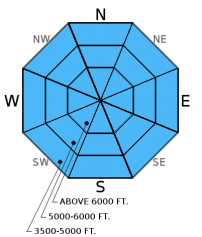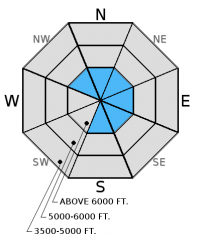| Wednesday | Wednesday Night | Thursday | |
|---|---|---|---|
| Cloud Cover: | Light snow beginning this morning. | Increasing snow. | Snow beginning to taper. |
| Temperatures: | 21 to 28 deg. F. | 8 to 21 deg. F. | 19 to 28 deg. F. |
| Wind Direction: | Southwest | Southwest | Southwest |
| Wind Speed: | 5-10 mph. | 5-10 mph. | 7-10 mph. |
| Snowfall: | 1 in. | 2-4 in. | 1-3 in. |
| Snow Line: |
Whitefish Range
Flathead Range and Glacier National Park
How to read the forecast
The avalanche danger above 5000 feet is CONSIDERABLE. 6-20 inches fell across the advisory area. Cautious route-finding, careful snowpack evaluation, and conservative decision making are still essential. Human triggered avalanches are still likely on steep slopes today. Today's snowfall will be limited, but watch for lingering, sensitive storm slabs and wind slabs at upper elevations. See Swan Range advisory here.

3. Considerable
?
Above 6500 ft.
3. Considerable
?
5000-6500 ft.
2. Moderate
?
3500-5000 ft.
- 1. Low
- 2. Moderate
- 3. Considerable
- 4. High
- 5. Extreme
-
Type ?
-
Aspect/Elevation ?

-
Likelihood ?CertainVery LikelyLikelyPossible
 Unlikely
Unlikely -
Size ?HistoricVery LargeLargeSmall

New snow at all elevations has created a storm slab concern throughout our advisory area. On steeper convex rollovers soft slabs were easily triggered yesterday, and I suspect these slabs will still be sensitive on steep slopes today. We also observed small natural storm slabs on steep slopes as well. Because this is a surface snow problem it is easy to identify. Dig into the new snow and see how this layer is bonding to the recent snow from this weekend. This new snow needs time to stabilize so cautious route finding and conservative decision making are essential again today.
-
Type ?
-
Aspect/Elevation ?

-
Likelihood ?CertainVery LikelyLikelyPossible
 Unlikely
Unlikely -
Size ?HistoricVery LargeLargeSmall

Winds increased yesterday afternoon enough to begin forming wind slabs at upper elevations. Today should be a great day for identifying wind slabs. Look for obvious signs of instability like cracking and collapsing in denser pockets of snow. Continue to carefully evaluate wind-loaded areas before skiing or riding the slope. Wind slabs are easy to identify. Look for smooth, convex pillows along leeward ridgelines and cross-loaded gullies.
-
Type ?
-
Aspect/Elevation ?

-
Likelihood ?CertainVery LikelyLikelyPossible
 Unlikely
Unlikely -
Size ?HistoricVery LargeLargeSmall

The primary persistent slab concern continues to be the weak, faceted snow above and below the Dec. 9 crust. This layer is generally found now 2.5 to 3.5 feet from the surface and exists in most locations across the advisory area. So far, we have not seen avalanche activity associated with this weak snow, but it is hard to say just how much weight it can handle. Continue to dig into the snow and assess this layer before committing to a slope and keep in mind the additional stress we put on this weak snow as this active weather pattern continues.
In some locations in the Flathead Range, Glacier Park, and parts of the Swan Range we noted and have received observations of weak, sugary snow near the ground. In some places it breaks and propagates across a column in stability tests, and sometimes it doesn't even break. With the December 9 rain crust fairly thick in places, it makes affecting these deeper layers more difficult. Though it appears very isolated in distribution, it is worth mentioning that skiers in the southern Whitefish Range found buried surface hoar Sunday which further illustrates the importance of digging in the snow to see what is going on below you.
Yesterday, my partner and I traveled to the Marion Lake area in the Flathead Range (observation 1 and video) where we stuck to slopes much less than 35 degrees. There was about 14-16 inches of light, new snow that on small convex rollovers formed soft slab avalanches (observation 2 and photo). They did not propagate very wide, but the slopes were relatively small. The debris entrained enough snow
On both Sunday and Monday BNSF Avalanche Safety reported natural avalanche activity in the John F Stevens Canyon. Sundays avalanches were thin wind slabs (10-12 inches) that failed Saturday night and Sunday morning (observation and photo).
On Sunday Todd traveled to Red Meadow in the northern Whitefish Range Sunday and found 15-20 inches of snow on top of the Dec. 9 crust. This crust was nearly 5 inches thick (Photo) at 7200 feet and though weak snow existed around the crust it did not fail in stability tests.
Also on Sunday, skiers on the Autumn Creek trail in southern Glacier National Park observed wind drifting snow on surrounding peaks and found the Dec. 9 crust was decomposing 2 feet from the surface (Observation). Other skiers were on Skookoleel Ridge in the southern Whitefish Range and in an isolated location found buried surface hoar that failed and propagated in stability tests (Observation).
Visit our Observations page and our You Tube channel for more information from the entire season.
Please let us know what you are seeing out there. Your observations are important and valued.
HOW TO SUBMIT OBSERVATIONS:
Email: [email protected]
Call and leave a message: 406.387.3821
You can also submit quick observations via text: 406.241.4571 (FAC mobile)
OR
Submit Snowpack Observations: http://www.flatheadavalanche.org/node/add/snowobs
Submit Avalanche Observations: http://www.flatheadavalanche.org/node/add/avyobs
The storm Monday into Tuesday brought 6-20 inches across the advisory area (0.3 to 2.5 inches of snow water equivalent) with the Swan Range receiving the bulk of the liquid amounts. As of 5:00 a.m. mountain weather stations are reporting 3-8 inches of new snow within the past 24 hours with snowfall ending by yesterday afternoon/evening. Currently, temperatures above 6000 feet range from 11º-20º F with winds 5-10 mph gusting to 15 mph out of the southwest. Today, expect 1-3 inches of snow throughout the day with temperatures ranging in the upper teens to low 20s. Winds will be out of the southwest at 5-10 mph with gusts to 25 mph (closer to the Continental Divide).
| 0600 temperature: | 11 to 20 deg. F. |
| Max. temperature in the last 24 hours: | 19 to 23 deg. F. |
| Average wind direction during the last 24 hours: | Southwest |
| Average wind speed during the last 24 hours: | 2 to 13 mph |
| Maximum wind gust in the last 24 hours: | 17 to 19 mph |
| New snowfall in the last 24 hours: | 3 to 8 inches |
| Total snow depth: | 54-63 inches |
This advisory applies only to backcountry areas outside established ski area boundaries. This advisory describes general avalanche conditions and local variations always occur. This advisory expires at midnight on the posted day unless otherwise noted. The information in this advisory is provided by the USDA Forest Service who is solely responsible for its content.








































